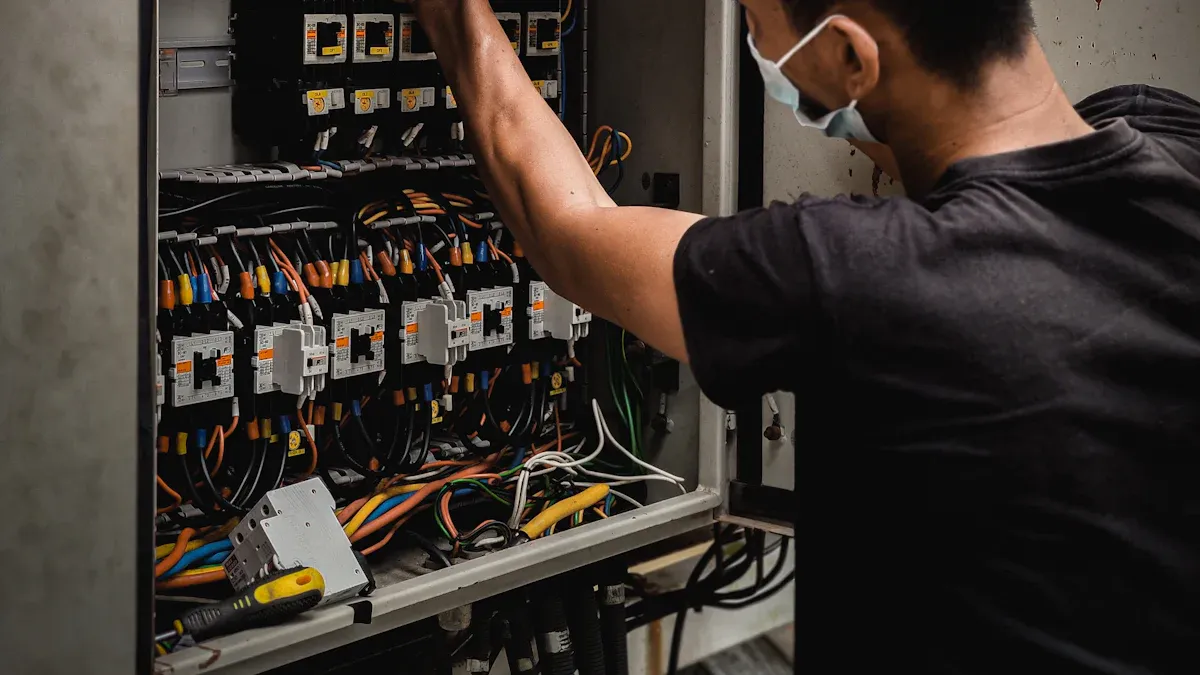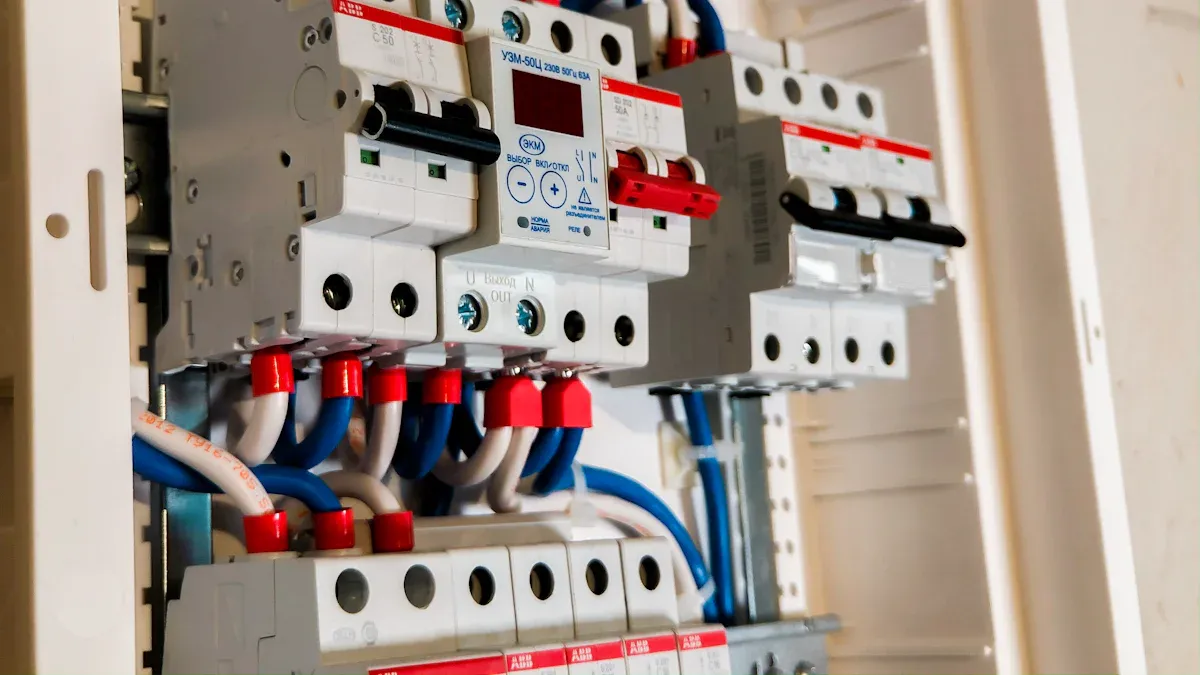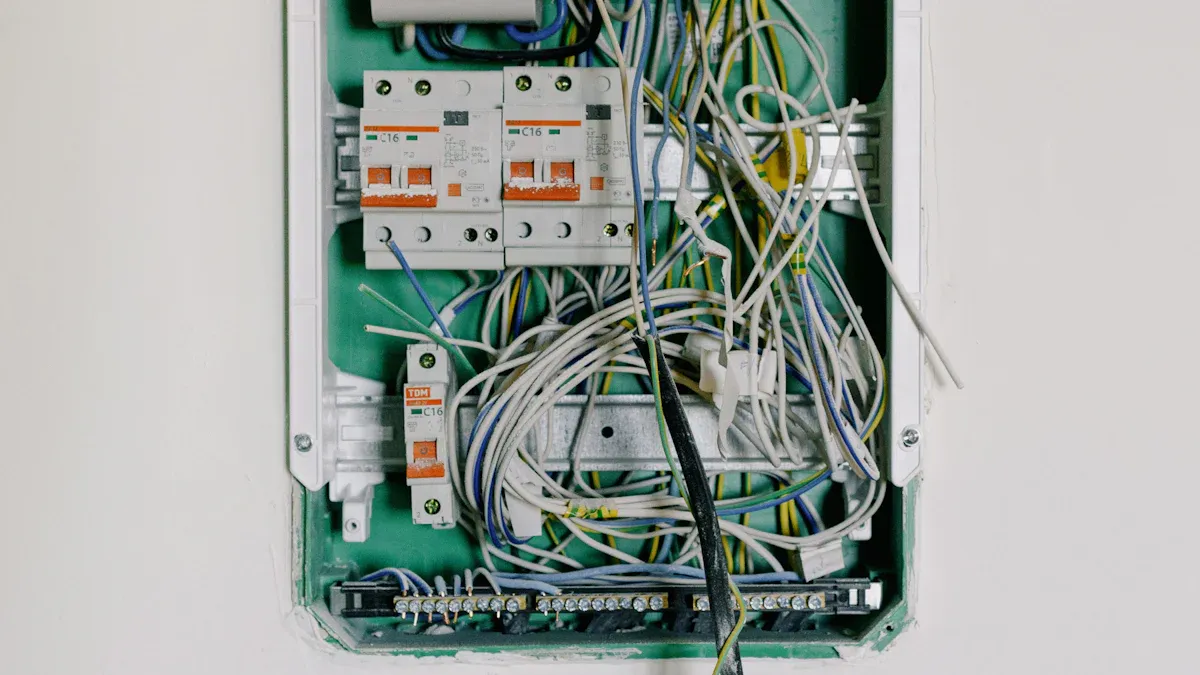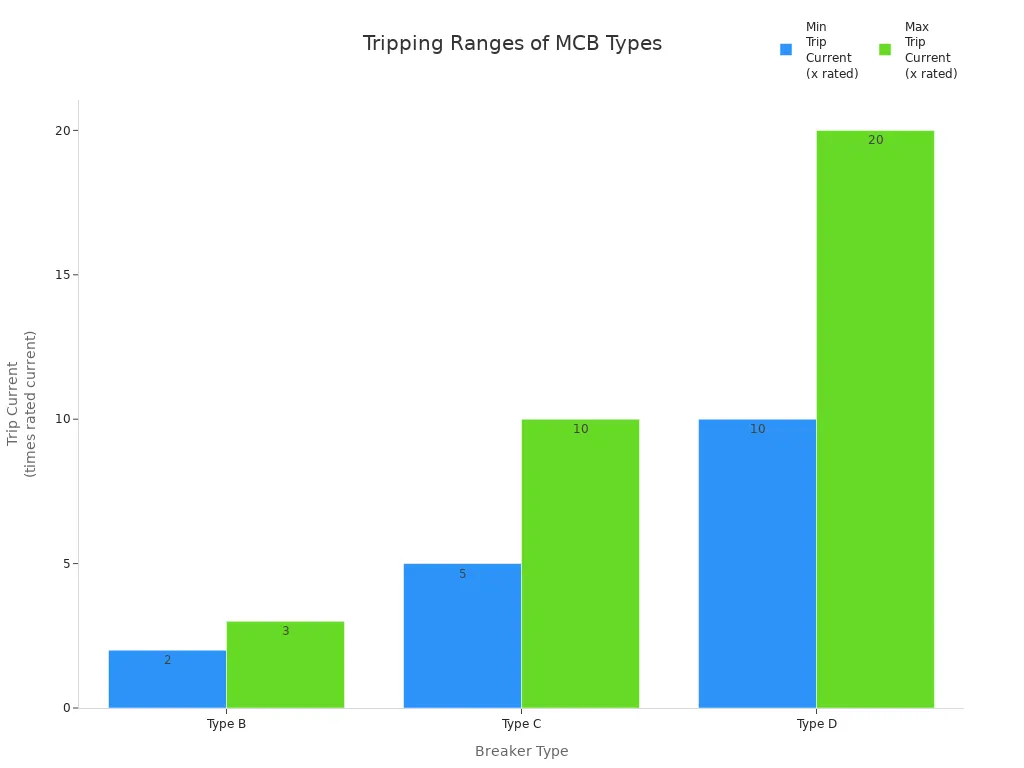
Views: 0 Author: Site Editor Publish Time: 2025-08-05 Origin: Site

A miniature circuit breaker (MCB) stops electricity if it finds danger, like too much current or a short circuit. You use an MCB to keep your wires and devices safe from harm and fire. These devices notice too much current and quickly stop the flow, so they are very important for safety.
MCBs are important for safety at home and work. New miniature circuit breakers stop electrical fires better than old ones.
Sector | MCBs Installed Globally (2024) |
|---|---|
Residential | |
Commercial | 700 million units |
A miniature circuit breaker (MCB) keeps your home and devices safe. It stops electricity if there is too much current or a short circuit.
MCBs have two ways to protect you. They use a thermal trip for slow overloads. They use a magnetic trip for quick surges. This makes them fast and dependable.
There are different MCB types for different jobs. Type B works best in homes. Type C is good for motors. Type D is for heavy machines.
You can reset an MCB easily after it trips. This saves time and money. Fuses need to be replaced, but MCBs do not.
Always pick certified MCBs like HAIPART’s. This helps keep your electrical system safe and working well.

You might ask, what is an MCB? An MCB is a small device that keeps your electrical circuits safe. It turns off the electricity by itself if it finds too much current or a short circuit. The International Electrotechnical Commission, called IEC, has a rule for MCBs. This rule is IEC 60898-1. It says an MCB is a low-voltage circuit breaker for places like homes, schools, shops, and offices. An MCB can handle up to 125A of current. It can also stop very high fault currents, up to 25,000A.
A miniature circuit breaker protects your circuits in two ways:
A thermal trip works when the current slowly gets too high.
A magnetic trip works fast when there is a sudden surge.
You do not have to replace an MCB after it trips. You just reset it and the power comes back. This makes it easy and safe to use at home or work.
HAIPART is a top company in China that makes miniature circuit breakers. Their MCBs follow the IEC 60898-1 rule. You can trust their products to keep you safe.
The main job of a miniature circuit breaker is to keep you and your things safe from electrical dangers. Using an MCB protects your wires, appliances, and equipment from too much current or faults. Here are some important things an MCB does:
It shuts off power if there is an overload or short circuit.
It uses both thermal and magnetic trips for full protection.
It has a bimetallic strip for slow overloads and a magnetic coil for quick spikes.
It has contacts that open to break the circuit and a reset button for easy use.
Function | How It Protects You |
|---|---|
Overload Protection | Stops wires from overheating |
Short Circuit Protection | Prevents fires and equipment damage |
Easy Reset | Lets you restore power quickly |
Reliable Operation | Works in homes, offices, and factories |
You can find MCBs in many places, like homes, schools, shops, and factories. HAIPART sells many types of miniature circuit breakers for all these places. Their products have ISO 9001, CE, and RoHS certificates. This shows they care about quality and safety. If you pick an MCB from HAIPART, you get a device that meets world standards and keeps your electrical system safe.

A miniature circuit breaker, or MCB, has several important parts that work together to keep your electrical system safe. Each part has a special job to detect problems and stop dangerous current flow.
The housing is the outer shell of the MCB. You will notice that it feels sturdy and solid. Manufacturers use flame-retardant materials for the housing. This helps the MCB resist high temperatures and prevents fire hazards. The housing must also handle the energy from electrical arcs during short circuits. If the housing material is weak or too thin, it can break when the arc energy is high. High-quality MCBs use strong plastics and metals, like copper, to make sure the housing stays safe and durable. The housing also protects the inside parts from dust and moisture, so your MCB lasts longer.
Inside the MCB, you find the contacts. These metal pieces touch each other when the circuit is on, letting current flow through. When the MCB detects a problem, the contacts separate quickly to stop the current flow. The contacts work with both the thermal and magnetic trip mechanisms. When the contacts open, an arc forms, but the MCB directs this arc into a special chamber to put it out safely. This design lets your MCB break the circuit fast and keeps you safe from electrical faults.
The contacts move because of the trip mechanisms.
The arc chamber puts out the arc when the contacts open.
You can reset the contacts after a trip, so the MCB is ready to use again.
The thermal trip protects you from slow overloads. It uses a bimetal strip inside the MCB. When too much current flow passes through, the strip heats up and bends. This bending moves a bar that opens the contacts and stops the current flow. The hotter the strip gets, the faster it bends and trips the breaker. This means the MCB reacts faster to bigger overloads, keeping your wires and devices safe.
The bimetal strip heats up from overload current flow.
The strip bends and moves the trip bar.
The trip bar opens the contacts, stopping the current flow.
The magnetic trip acts when there is a sudden, large current flow, like during a short circuit. Inside the MCB, an electromagnetic coil creates a strong magnetic field when this happens. The field pulls an armature, which quickly opens the contacts. This fast action stops the dangerous current flow before it can cause damage or fire. The magnetic trip works almost instantly, giving you quick protection.
The coil senses high current flow.
The armature moves and opens the contacts.
The circuit breaks right away to prevent harm.
You control the MCB with the lever. The lever lets you turn the circuit on or off by hand. After the MCB trips, you can reset it by flipping the lever back to the ON position. The lever design makes it easy to use, even in tight spaces. You will see a clear sign, like a red flag, when the MCB has tripped. This helps you know the status at a glance. The lever also keeps the circuit off until you are ready to turn it back on, so you stay safe during repairs or checks.
Tip: Always turn off your devices before resetting the MCB to avoid sudden surges or hazards.
Knowing how a miniature circuit breaker works helps you see how it keeps you safe. The MCB uses two ways to trip: thermal and magnetic. These help it find too much current and stop dangerous flow. Let’s see how the MCB protects you in different cases.
When everything is normal, the MCB lets electricity move safely. The idea is simple. The MCB stays shut, so current goes from the start terminal, through the inside wire, and out to your things. The bimetallic strip and magnetic coil do nothing because the current is not too high. The tripping parts stay off, so your lights and devices work fine.
Here is what happens when things are normal: 1. Current enters the MCB and moves through the inside wire. 2. It passes through the closed contacts. 3. The current goes to your devices with no problem. 4. The bimetallic strip stays cool and flat. 5. The magnetic coil does not make a strong field. 6. The trip spring keeps the contacts closed, so the circuit works.
If you use a HAIPART miniature circuit breaker, you get safe and steady protection. These breakers follow IEC 60898 rules, so they work well with normal loads.
Overload protection is a big part of how an MCB works. If you plug in too many things or one device uses too much current, the current goes above the safe level. The bimetallic strip inside the MCB gets hot as the extra current keeps going. If this lasts, the strip bends and starts the trip. This opens the contacts and stops the current, so your wires and devices do not get too hot.
Component | Function |
|---|---|
Bimetallic Strip | Finds overload by heating and bending, which starts the trip |
Electromagnet | Acts fast when there is a sudden surge or short circuit |
Tripping Mechanism | Breaks the circuit to stop power flow |
The MCB’s overload protection keeps your home or business safe. HAIPART’s thermal-magnetic trip design acts fast and right when there is too much current. This meets strict IEC rules for overload safety.
Note: Overload protection works best if you pick the right MCB for your needs.
Short circuit protection is another key part of how an MCB works. A short circuit happens when a live wire touches a neutral or ground wire. This makes a sudden, big current. The magnetic coil in the MCB feels this right away. It makes a strong field that pulls the trip bar and starts the trip. The contacts open almost at once, stopping the current and keeping you safe from fire or damage.
Trip Curve Type | Typical Short-Circuit Trip Threshold (Multiples of Rated Current) | Application / Sensitivity |
|---|---|---|
Z | 2 to 3 times | Very sensitive, like for electronics |
B | 3 to 5 times | General use, reacts to small surges |
C | 5 to 10 times | Medium surges, used in stores |
K | 10 to 14 times | Big surges, for motors and transformers |
D | 10 to 20 times | Very big surges, for heavy machines |

HAIPART’s miniature circuit breakers give strong short circuit protection. Their products can handle big fault currents and meet IEC safety rules.
Resetting the MCB is easy and safe if you do it right. After a trip, you need to put the breaker back to normal. This is part of what makes MCBs simple to use.
Here is how you reset the MCB: 1. Turn off lights and unplug things in the area to lower the load. 2. Go to your panel and find the tripped MCB. It will be in the middle or off spot. 3. Move the breaker all the way off, then turn it back on. 4. If it trips again, look for too much current, broken cords, or wiring problems. 5. If you cannot fix it, call a licensed electrician for help.
Always stand to the side and only touch the plastic lever when you reset the MCB. This keeps you safe from sparks or shocks.
HAIPART’s MCBs have a clear lever, so resetting is simple and safe. Their products mix new breaker technology with easy-to-use features.
There are different types of miniature circuit breakers. Each type has a special job to do. The main types are Type B, Type C, and Type D. Each one protects your circuits in its own way. They trip at different current levels before shutting off.
Type B miniature circuit breakers trip at 3 to 5 times the rated current. People use them mostly in homes and small shops. They work well for lights, outlets, and small appliances. These things do not cause big surges when turned on. Type B is good for protecting sensitive devices and lighting.
Trips fast at low current surges
Best for lights, outlets, and small appliances
Used in homes and light commercial places
Tip: Pick Type B for rooms with lights and electronics. It helps keep your home safe from small power surges.
Type C miniature circuit breakers trip at 5 to 10 times the rated current. You find these where there are motors or air conditioners. They are also used for fluorescent lights. These loads make medium surges when starting up. Offices, shops, and small factories use Type C often. It protects without tripping too easily.
Type C works well for:
Power lines with higher starting currents
Circuits with motors or transformers
Commercial and industrial places
Choose Type C if your building has equipment that uses more power when starting.
Type D miniature circuit breakers trip at 10 to 20 times the rated current. They are made for heavy machines and big motors. Type D can handle large surges, so it does not trip when big machines start. You see these in factories, workshops, and places with welding tools or elevators.
Feature | Type D Miniature Circuit Breakers |
|---|---|
Tripping Threshold | 10-20 times rated current |
Typical Applications | Large motors, welding equipment, elevators |
Response Time | Slowest, allows for high startup surges |
Voltage/Current Ratings | 230V/400V, 0.5A to 125A |
Note: Do not use Type D for sensitive electronics. It is best for heavy-duty machines.
You must match the miniature circuit breaker type to your electrical load. Here is a simple guide:
Breaker Type | Trip Current Range (times rated current) | Typical Applications | Key Characteristics |
|---|---|---|---|
Type B | 2-3 | Lighting, outlets, small appliances | Trips fast, best for sensitive and home circuits |
Type C | 5-10 | Motors, air conditioners, commercial lighting | Handles medium surges, good for general commercial use |
Type D | 10-20 | Large motors, industrial machines, welding equipment | High surge tolerance, best for heavy industrial applications |

Choosing the right miniature circuit breaker keeps your building safe. It also helps your equipment work well. Always check what kind of load you have and pick the right type.
You count on an mcb to keep places safe. It can be your home, office, or factory. The mcb turns off power fast if there is a problem. This could be too much current or a short circuit. Turning off the power helps stop fires and shocks. It also keeps your equipment from breaking. HAIPART’s miniature circuit breakers follow strict safety rules. These rules are IEC, ISO 9001, CE, and RoHS. You know you get good protection with these. Picking a certified mcb adds more safety to your system.
There are many reasons to use an mcb instead of a fuse:
Safety: An mcb stops too much current and short circuits. It lowers the risk of fire and shock.
Convenience: You can reset an mcb after it trips. You do not have to buy a new one like a fuse.
Cost-effectiveness: An mcb lasts longer and needs less care. This saves you money over time.
Tip: An mcb shows you if it has tripped. You can turn the power back on fast, unlike with fuses.
You need to pick the right mcb for good protection. Here are some things to think about:
Factor | What You Should Check |
|---|---|
Trip Curve (Type B, C, D) | Match the mcb type to what you use it for. Type B is for lights. Type C is for motors. Type D is for big machines. |
Number of Poles | Use single-pole for simple jobs. Use three-pole for big or three-phase systems. |
Current and Voltage Ratings | Make sure the mcb matches your devices and system. |
Breaking Capacity | Pick an mcb that can stop the biggest fault current. |
Safety Compliance | Choose mcbs with IEC, CE, and ISO certificates. |
HAIPART sells single-pole and three-pole mcbs. You can find the right one for your job.
People sometimes make mistakes with mcbs. Here are some errors and how to stop them:
Mistake | How to Avoid |
|---|---|
Picking the wrong mcb type | Learn about your devices and pick the right trip curve. |
Oversizing the mcb | Do not pick a bigger mcb just to stop tripping. Match it to your devices. |
Ignoring environmental factors | Check the temperature and follow the maker’s advice. |
Forgetting about safety standards | Always use certified mcbs and follow the instructions. |
Note: Always read the maker’s datasheet before you put in any mcb. This helps you stay safe.
A miniature circuit breaker helps keep places like homes and schools safe. It quickly stops dangerous currents before they cause harm. This protects your electrical system from overloads and short circuits. Your power stays steady and your devices are safer.
Aspect | Miniature Circuit Breaker |
|---|---|
Main Role | Cuts power if there is a problem |
Typical Use | Used in homes, schools, and hospitals |
Safety Feature | You can reset it by hand and it keeps you safe |
Importance | Stops fires and saves your equipment |
Pick a certified miniature circuit breaker from HAIPART. Their products have new technology and strong quality checks. This helps you feel safe and worry less.
If your MCB trips often, unplug your devices and check for overloads or faulty appliances. Try resetting the breaker. If it trips again, call a licensed electrician. Do not ignore repeated trips. This could mean a serious wiring problem.
Yes, you can replace a fuse with an MCB. MCBs offer better safety and are easier to reset. Make sure you choose the correct type and rating for your circuit. Ask a professional for help if you are unsure.
Check what devices or machines you want to protect. Use Type B for lights and outlets, Type C for motors, and Type D for heavy machines. Always match the MCB type to your load for the best protection.
Certified MCBs, such as those from HAIPART, meet strict safety standards. You get reliable protection, quality materials, and peace of mind. Look for IEC, CE, and ISO marks on your breaker for extra safety.